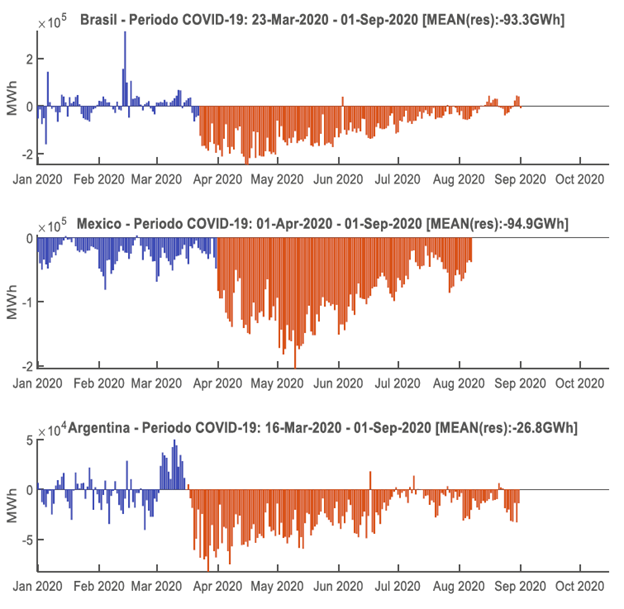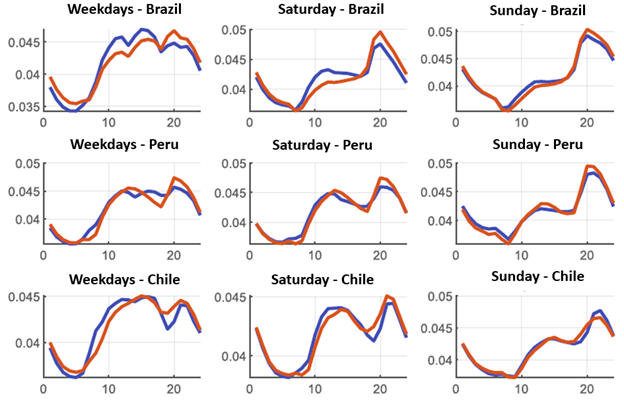As the number of vaccines rises and vaccinations programs throughout Latin America and the Caribbean (LAC) take up different speeds, the end of the covid pandemic is within sight. From the Energy division in the IDB, we have been tracking the impact the covid transformative effects in LAC’s behaviors and economic activity have on utilities. While the pandemic grew in strength and different measures were taken, the amount of energy sold in the countries’ regions dropped with potentially consequential effects on utility finances. Therefore, we explored how the pandemic transformed electricity demand in the region.
Using the comparison between the real impact of the pandemic and the baseline year without a pandemic, it is identified that the maximum drop in demand in the countries analyzed was 15%, with weekly effects ranging between 34% and 8%. In the most critical moments of the pandemic, during the month of April, countries like Peru stopped consuming 1 of every 3 kWh than previously expected. This blog has been covering this topic extensively during the last year (1,2,3 y 4).
This estimation gives comparative insight into the dimension of the demand reduction that might cause these issues. In the “Impacto del COVID-19 en la demanda de energía eléctrica en Latinoamérica y el Caribe” we have produced a calculation of what might have been a regular year covering the events of the first half of last year’s pandemic. These calculations have been based on past evidence with models calibrated to each country’s consumption patterns and sensitivities. We used different variables that generally affect consumption, such as weekly patterns, temperature, holidays, local festivities, and disruptive events of varying degrees such as strikes and natural disasters.
Changes in routine and the consumption alike
This baseline year allows establishing a lost energy demand that can be used to calculate the impact of covid on different activities and provide a better response to changes throughout last year. This approach is better than prior year comparisons subject to localized events and changes in variables such as temperatures or disasters. These localized deviations from the trend would have skewed the calculations and shifted the results of lost demand. In addition, this document allows us to look towards the future, and use the IMF GDP forecasts to project different recovery scenarios, and during the current year, and help plan the recovery as the pandemic subsides.

When looking at changes in the day, the analysis identifies how Brazil, Mexico, Bolivia, or Chile reduced their consumption, especially at midday and during the hours where people used to go back home. Others, such as Guatemala, experienced increases during the early hours of the morning and the late hours of the night and drops during the afternoon. These variations in time of consumption during the day have important implication for the operation of the electrical grid, and the cost from electricity since the prices of generation varies with the time of consumption and the mix of generators producing electricity at that time. Renewables, for example, tend to be present during the sunny hours and the windy hours of the early morning and late afternoon.
For some countries, the changes in demand load were temporary, with intense variations in the first weeks and a quick return to normal. We found these cases in Bolivia and Brazil. However, for most other, the changes were long-lasting and focused on working weekdays. In the last period analyzed, countries had approached a more minimal difference with the baseline year at an average 5.3% difference as more months of the pandemic had passed.

All these changes can be seen through the prism of the GDP. The IMF has forecasted in their World Economic Outlook drops of up to 19% and 16% in GDP in Peru and the Dominican Republic. However, the countries where a dropping in demand was estimated have seen a more modest decline in GDP with a 3% drop in the case of Costa Rica. This drop-in GDP might take some time to recover with the resulting long-lasting impact on demand.
The regional perspective presented in this report also shows the impacts of the pandemic are inherently national. Each citizenry has reacted in a particular way, potentially motivated by the type of economic structure existing in the country, the customs of time use, and the kind of industrial activity and services that the country offers. With this information and analysis, the system’s operation can be better adjusted so that prices do not heavily variate, and service is provided effectively during this type of eventualities. This points to the need for adaptable and flexible electrical systems that can respond to potential changes in population demand.


Leave a Reply